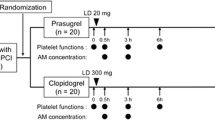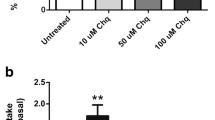Summary
The aims of this study were to evaluate whether the β-blocking effect during propafenone treatment is clinically significant even in extensive metabolisers of debrisoquine (> 90% of Caucasians), and to identify the kinetic determinants of such an effect. 11 patients, classified as extensive oxidisers of debrisoquine, with stable ventricular contractions (> 100/hour) were studied by Holter monitoring in basal condition and after 14 days of treatment with propafenone 300mg 3 times daily. A complete pharmacokinetic assessment, with serial plasma samples for propafenone and 5-hydroxy propafenone determination, was performed during washout.
A mean reduction in either maximum heart rate (HR max) [−7.1%] or mean heart rate (HR mean) [−4.2%] was observed during treatment with propafenone, but its extent varied within the patient population from 0 to 17%. The degree of HR slowing was related to the area under the concentration-time curve of propafenone (r = 0.725, p < 0.02 for HR max; r = 0.715, p < 0.02 for HR mean) as well as to propafenone minimum concentrations at steady-state (r = 0.809, p < 0.005 for HR max; r = 0.752, p < 0.01 for HR mean) without significant relationships to 5-hydroxy propafenone levels or to age. HR max percentage reduction during therapy was significant compared with basal values only during daytime hours (−8.1%, p < 0.005), suggesting a β-blocking effect, and was again related to the area under the concentration-time curve of propafenone (r = 0.704, p < 0.02) and to propafenone minimum steady-state concentrations (r = 0.786, p < 0.005). A strict relationship between oxidative metabolism, evaluated by debrisoquine hydroxylation and propafenone metabolism, was observed (r = 0.982, p < 0.001).
In conclusion, a β-blocking effect during treatment with propafenone 300mg 3 times daily can be detected even by Holter monitoring performed during daily activity. However, the extent of such an effect varies widely between individuals, depending on propafenone plasma levels. The degree of oxidative metabolism is thus a major determinant of the clinical β-blocking effect of propafenone.
Similar content being viewed by others
References
Boriani G, Strocchi E, Capucci A, Boschi S, Marchesini B, et al. Relationships between debrisoquine hydroxylation and propafenone pharmacokinetics. Drug Investigation 2: 114–119, 1990
Brode E, Sachse R, Hoffman HD. Untersuchungen der analitik von propafenone mittels interner analogstandardsierung. Arzneimittel Forschung 32: 1–6, 1982
Burnett DM, Gal J, Zahniser NR, Nies AS. Propafenone interacts stereoselectively with B1 - and B2-adrenergic receptors. Journal of Cardiovascular Pharmacology 12: 615–619, 1988
Capucci A, Boriani G, Marchesini B, Strocchi E, Tomasi L, et al. Minimal effective concentration values of propafenone and 5-hydroxy-propafenone in acute and chronic therapy. Cardiovascular Drugs and Therapy 4: 281–287, 1990
Cheriex EC, Krijne R, Brugada P, Heymericks J, Wellens HJ. Lack of clinically significant β-blocking effect of propafenone. European Heart Journal 8: 53–56, 1987
Connolly S, Kates RE, Lebsack CS, Harrison DC, Winkle RA. Clinical pharmacology of propafenone. Circulation 68: 589–596, 1983
Coumel P, Attuel P, Leclercq JF, Friocourt P. Arythmies auricolaires d’origine vagale ou catécholergique. Effects comparés du traitement beta-bloquant et phénomène d’echappement. Archives des Maladies du Coeur et des Vaisseaux 75: 373–388, 1982
Coumel P, Leclercq JF, Assayag P. European experience with the antiarrhythmic efficacy of propafenone for supraventricular and ventricular arrhythmias. American Journal of Cardiology 54: 60D–66D, 1984
Dukes ID, Vaughan-Williams EM. The multiple modes of action of propafenone. European Heart Journal 5: 115–125, 1984
Funck-Bentano C, Kroemer HK, Lee JT, Roden DM. Propafenone. New England Journal of Medicine 322: 518–525, 1990
Harrison PM, Tonkin AM, Dixon ST, McLean AJ. Determination of debrisoquine and its 4-hydroxy metabolite in urine by high-performance liquid chromatography. Journal of Chromatography 374: 204–208, 1986
Kalow W. Ethnic differences in drug metabolism. Drugs 7: 373–400, 1982
Kates RE, Yee YG, Winkle RA. Metabolite cumulation during chronic propafenone dosing in arrhythmia. Clinical Pharmacology and Therapeutics 37: 610–614, 1985
Kroemer HK, Funck-Bentano C, Silberstein DJ, Wood AJJ, Eichelbaum M, et al. Stereoselective disposition and pharmacologic activity of propafenone enantiomers. Circulation 79: 1068–1076, 1989
Ledda F, Mentelli L, Manzini S, Amerini S, Mugelli A. Electrophysiological and anti-arrhythmic properties of propafenone in isolated cardiac preparations. Journal of Cardiovascular Pharmacology 3: 1162–1173, 1981
Lee JT, Kroemer HK, Silberstein DJ, Funck-Bentano C, Lineberry MD, et al. The role of genetically determined polymorphic drug metabolism in the β-blockade produced by propafenone. New England Journal of Medicine 322: 1764–1768, 1990
Lombardi F, Torzillo D, Sandrone G, Dalla Vecchia L, Finocchiaro ML, et al. β-Blocking effect of propafenone based on spectral analysis of heart rate variability. American Journal of Cardiology 70: 1028–1034, 1992
Malfatto G, Zaza A, Forster M, Sodowick B, Danilo P, et al. Electrophysiologic, inotropic and antiarrhythmic effects of propafenone, 5-hydroxypropafenone and N-depropylpropafenone. Journal of Pharmacology and Experimental Therapeutics 246: 419–426, 1988
Malfatto G, Zaza A, Schwartz PJ. Propafenone blunts the heart rate response to sympathetic neural stimulation. Abstract. European Heart Journal 12 (Suppl.): 420, 1991
Marchesini B, Tomasi L. Effects of modifiers on the chromatographic behaviour of propafenone and its major metabolites. Chromatographia 34: 753–758, 1987
McLeod AA, Stiles GL, Shand DG. Demonstration of beta adrenoceptor blockade by propafenone hydrochloride. Clinical, pharmacologic, radioligand binding and adenylate cyclase activation studies. Journal of Pharmacology and Experimental Therapeutics 228: 461–466, 1984
Morganroth J, Borland M, Chao G. Application of a frequency definition of ventricular proarrhythmia. American Journal of Cardiology 59: 97–99, 1987
Müller-Peltzer H, Greger G, Neugebauer G, Hollmann M. Beta-blocking and electrophysiological effects of propafenone in volunteers. European Journal of Clinical Pharmacology 25: 831–833, 1983
Philisborn Gv, Gries J, Hofmann HP, Kreiskott R, Kretzchmar R, et al. Pharmacological studies on propafenone and its main metabolite 5-hydroxypropafenone. Arzneimittel Forschung 34: 1489–1497, 1984
Podrid PJ, Cytryn R, Lown B. Propafenone: noninvasive evaluation of efficacy. American Journal of Cardiology 54: 53D–59D, 1984
Price Evans DA, Mahgoub A, Sloan TP, Idle JR, Smith RL. A family and population study on the genetic polymorphism of debrisoquine oxidation in a white British population. Journal of Medical Genetics 17: 102–105, 1980
Rouet R, Libersa CC, Broly F, Caron JF, Adamantidis MM, et al. Comparative electrophysiological effects of propafenone, 5-hydroxy-propafenone and N-depropylpropafenone on guinea pig ventricular muscle fibers. Journal of Cardiovascular Pharmacology 14: 577–584, 1989
Seipel L, Breithardt G. Propafenone — a new antiarrhythmic drug. European Heart Journal 1: 309–313, 1980
Siddoway LA, Thompson KA, McAllister B, Wang T, Wilkinson GR. Polymorphism of propafenone metabolism and disposition in man: clinical and pharmacokinetic consequences. Circulation 75: 785–791, 1987
Steiner E, Bertilsson L, Sawe J, Bertling I, Sjoqvist F. Polymorphic debrisoquin hydroxylation in 757 Swedish subjects. Clinical Pharmacology and Therapeutics 44: 431–435, 1988
Author information
Authors and Affiliations
Rights and permissions
About this article
Cite this article
Boriani, G., Capucci, A., Strocchi, E. et al. β-Blocking Properties of Propafenone in Extensive Oxidisers: A Study on Heart Rate Behaviour during Holter Monitoring. Drug Invest 6, 25–32 (1993). https://doi.org/10.1007/BF03259424
Published:
Issue Date:
DOI: https://doi.org/10.1007/BF03259424




